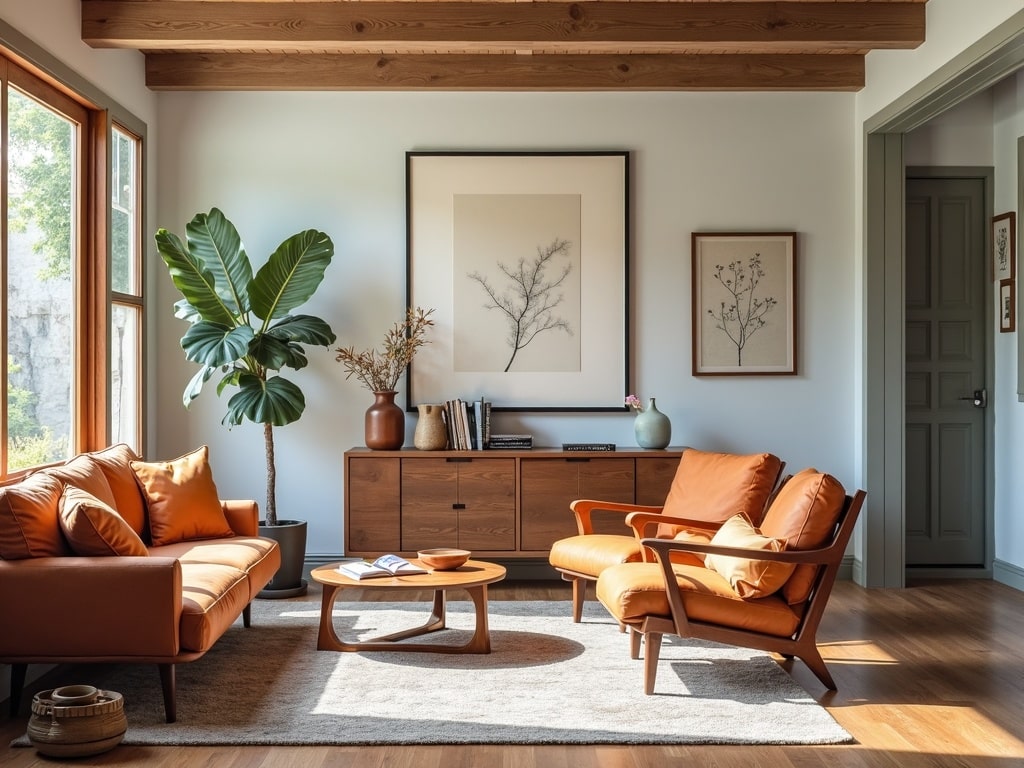Handcrafted Furniture: Where Timeless Design Meets Modern Living
Imagine a piece of furniture, not just assembled in a factory, but born from the hands of a skilled artisan, imbued with character and designed to last generations. This is the essence of handcrafted furniture—a harmonious blend of artistry, quality materials, and meticulous attention to detail. In a world increasingly dominated by mass-produced items, handcrafted furniture offers a unique opportunity to bring individuality, sustainability, and enduring beauty into your home. But what exactly defines handcrafted furniture, and why should you consider it for your living space?
Defining Handcrafted Furniture: More Than Just Furniture
Handcrafted furniture isn't simply about assembling pre-cut pieces. It's a deliberate process where skilled artisans pour their expertise, creativity, and passion into every stage of creation. Key characteristics that define this art form include:
- Artisan Skill: Each piece reflects the maker's expertise, often honed over years of practice.
- Unique Design: Handcrafted furniture often features original designs or personalized adaptations,setting it apart from mass-produced items.
- Quality Materials: Artisans typically select premium materials, chosen for their beauty, durability, and sustainability.
- Attention to Detail: From joinery to finishing, every aspect is carefully executed to ensure longevity and aesthetic appeal.
- Limited Production: Unlike mass-produced items, handcrafted furniture is made in small batches or as individual pieces, adding to its exclusivity.
Handcrafted vs. Mass-Produced: A World of Difference
While both handcrafted and mass-produced furniture serve the same basic function, their differences are profound:
- Quality and Durability: Handcrafted furniture, with its superior materials and construction, is built to last for decades, if not generations. Mass-produced furniture often prioritizes cost-effectiveness, resulting in lower-quality materials and construction that may only last a few years.
- Uniqueness and Aesthetics: Handcrafted pieces offer a level of individuality and artistic flair unmatched by their mass-produced counterparts. Each piece tells a story and adds character to your home.
- Customization: Handcrafted furniture can be customized to your exact specifications, ensuring a perfect fit for your space and style. Mass-produced furniture offers limited customization options.
- Sustainability: Handcrafted furniture often utilizes sustainably sourced materials and eco-friendly practices, reducing its environmental impact. Mass production can involve resource-intensive processes and the use of unsustainable materials.
The Multifaceted Benefits of Choosing Handcrafted Furniture
Investing in handcrafted furniture goes beyond simply acquiring a functional object; it's an investment in art, quality, and sustainability. The benefits include:
- Exceptional Durability: Built with time-tested techniques and premium materials, handcrafted furniture is designed to withstand daily wear and tear, offering lasting value.
- Timeless Aesthetics: The unique designs and attention to detail in handcrafted pieces create a refined and elegant atmosphere in your home.
- Personalized Customization: Tailor your furniture to your exact needs, preferences, and space requirements, resulting in a truly unique and personalized piece.
- Sustainable Choice: Support eco-friendly practices and reduce your environmental impact by choosing furniture made from sustainably sourced materials.
- Investment Value: Handcrafted furniture can appreciate in value over time, becoming a cherished heirloom.
Exploring the Diverse World of Handcrafted Furniture
Handcrafted furniture encompasses a wide range of styles and pieces for every room in your home:
- Living Room: Sofas, armchairs, coffee tables, entertainment centers, and bookshelves crafted with comfort and style in mind.
- Bedroom: Beds, dressers, nightstands, and armoires designed to create a peaceful and inviting retreat.
- Dining Room: Dining tables, chairs, sideboards, and china cabinets that elevate your dining experience.
- Office: Desks, chairs, bookcases, and filing cabinets that combine functionality with aesthetic appeal.
The Materials That Define Quality: A Closer Look
The quality of materials is paramount in handcrafted furniture. Common materials and their unique qualities include:
- Wood Types:
- Hardwoods (Oak, Maple, Walnut, Cherry): Known for their durability, strength, and beautiful grain patterns.
- Softwoods (Pine, Cedar, Fir): Offer a more rustic aesthetic and are often used for accents or decorative elements.
- Metals: Wrought iron, steel, and brass are often used for frames, legs, and decorative hardware, adding strength and visual interest.
- Fabrics: High-quality natural fibers like linen, cotton, and wool are used for upholstery, offering comfort, durability, and a luxurious feel.
Identifying Quality: What to Look For in Handcrafted Furniture
Distinguishing high-quality handcrafted furniture from inferior pieces requires a keen eye. Pay attention to these key indicators:
- Construction Techniques: Look for solid wood construction, sturdy frames, and reinforced joints. Dovetail joints, mortise-and-tenon joints, and other traditional joinery methods indicate superior craftsmanship.
- Joinery: Examine the joints closely for tight fits, clean lines, and evidence of meticulous workmanship.
- Finishing: A smooth, even finish is a hallmark of quality. Look for multiple coats of varnish, lacquer, or oil, applied with precision.
- Hardware: High-quality hardware, such as solid brass hinges and pulls, adds to the overall durability and aesthetic appeal of the piece.
Caring for Your Investment: Ensuring Longevity

Proper care and maintenance are essential for preserving the beauty and longevity of your handcrafted furniture:
- Regular Cleaning: Dust regularly with a soft, dry cloth. For occasional cleaning, use a mild soap and water solution, followed by a thorough drying.
- Avoid Direct Sunlight: Exposure to direct sunlight can fade or damage the finish of your furniture. Use curtains or blinds to protect it.
- Control Humidity: Maintain a consistent humidity level in your home to prevent warping, cracking, or other damage to the wood.
- Use Coasters and Placemats: Protect surfaces from spills and heat damage by using coasters and placemats.
- Professional Care: Consider professional cleaning and polishing services to maintain the luster and beauty of your furniture.
Sustainability in Handcrafted Furniture: An Eco-Friendly Choice
Handcrafted furniture often aligns with sustainable living principles:
- Sustainable Materials: Artisans often use sustainably harvested wood, recycled materials, and eco-friendly finishes.
- Reduced Waste: Handcrafted production minimizes waste compared to mass production.
- Long Lifespan: The durability of handcrafted furniture reduces the need for frequent replacements, lowering your environmental impact.
- Support Local Artisans: Purchasing handcrafted furniture supports local economies and preserves traditional skills.
The Ever-Evolving Landscape: Trends in Handcrafted Furniture Design
While rooted in tradition, handcrafted furniture is also embracing modern trends:
- Mid-Century Modern: Clean lines, tapered legs, and organic shapes characterize this timeless style.
- Rustic Modern: Combining rustic elements with contemporary design, this style creates a warm and inviting atmosphere.
- Scandinavian: Emphasizing simplicity, functionality, and natural materials, Scandinavian design is perfect for creating a minimalist and serene space.
- Live Edge Furniture: Showcasing the natural edge of the wood, live edge pieces add a unique and organic element to your home.
Integrating Handcrafted Furniture: Achieving Timeless Modernity
Incorporating handcrafted furniture into your home decor can create a sophisticated and inviting space:
- Mix and Match: Combine handcrafted pieces with contemporary elements to create a balanced and eclectic look.
- Focus on Focal Points: Use a statement piece of handcrafted furniture as a focal point in your room.
- Embrace Natural Textures: Incorporate natural textures like wood, leather, and linen to complement the handcrafted aesthetic.
- Add Personal Touches: Accessorize with handcrafted items like pottery, artwork, and textiles to create a personalized space.
Where to Find Authentic Handcrafted Furniture
Finding authentic handcrafted furniture requires careful research:
- Online Marketplaces: Platforms like Etsy and online artisan collectives offer a wide selection of handcrafted furniture from independent makers.
- Local Artisans: Visit local craft fairs, art shows, and workshops to discover talented artisans in your area.
- Furniture Stores: Some furniture stores specialize in handcrafted or artisan-made pieces.
An Investment That Lasts: The Value of Handcrafted Furniture
Handcrafted furniture is more than just a purchase; it's an investment:
- Lasting Value: Due to its superior quality and durability, handcrafted furniture retains its value over time.
- Potential Appreciation: Some handcrafted pieces, especially those made by renowned artisans, can appreciate in value.
- Heirloom Quality: Handcrafted furniture can be passed down through generations, becoming a cherished family heirloom.
In conclusion, handcrafted furniture transcends mere functionality, embodying artistry, sustainability, and lasting value. By choosing handcrafted, you're not just furnishing your home; you're investing in a piece of art that will enrich your life for years to come, while supporting craftspeople and sustainable practices. Embrace the beauty and durability of handcrafted furniture – a timeless choice for the modern home.

